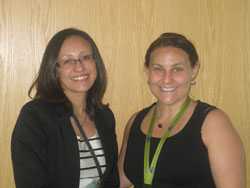Division of Bacterial Diseases (DBD) News Bulleti
This website is archived for historical purposes and is no longer being maintained or updated.
July 24, 2012: Content on this page kept for historical reasons.
In This Issue
- The Active Bacterial Core surveillance
- Meningitis in Sub-Saharan Africa
- Reducing Pneumonia
- OD News and Staff Notes
- Vaccine News
- Communications
- Featured Publications
Summer 2012
A Sound Approach for High Quality Data – The Active Bacterial Core surveillance (ABCs)
Since 1995, Active Bacterial Core surveillance (ABCs), an active, population and laboratory-based surveillance system has been an integral component of CDC’s Emerging Infections Program (EIP). ABCs’ data have proved valuable to the division, center and CDC’s overall mission of protecting the public’s health by describing the incidence and epidemiologic characteristics of invasive bacterial diseases due to groups A and B Streptococci (GAS and GBS), Haemophilus influenzae, Neisseria meningitidis, Streptococcus pneumoniae, and since 2005, Methicillin-resistant Staphylococcus aureus (MRSA).

Pictured above are Emily Weston (right), ABCs, along with Melony Fortuin-de Smidt (left) from GERMS-SA, The Group for Enteric, Respiratory and Meningeal disease Surveillance in South Africa who attended the May 12, 2012 ABCs Surveillance Officers’ Meeting to present on Haemophilus influenzae in South Africa.
ABCs provides a unique platform for advancing the understanding of the incidence and impact of ABCs pathogens, informing vaccine development, conducting post-licensure evaluation of vaccine efficacy, evaluating disease prevention and control measures, advancing laboratory methods and diagnostics, and informing national policy considerations in these areas. Today, the program’s surveillance catchment area includes 10 sites encompassing up to 42 million persons, accounting for about 13% of the US population. ABCs methods and results are shared with international groups.
ABCs core mission remains to track the incidence and epidemiology of emerging infectious diseases. In 2011, ABCs added surveillance for diseases caused by Legionella and Bordetella pertussis, which have become more common. According to Gayle Langley, a medical epidemiologist who became ABCs Project Director in 2011, "The addition of legionellosis surveillance will allow us to provide better estimates of disease incidence and severity of illness and determine where prevention efforts should be focused." The main goals of pertussis surveillance are to determine the incidence and epidemiologic characteristics of the illness among all age groups and monitor the impact of pertussis vaccines.
The uses of ABCs data are quite varied. The Advisory Committee on Immunization Practices (ACIP) recently used ABCs’ pneumococcal data in discussing the possible use of the 13-valent pneumococcal conjugate vaccine (PCV13) in adults and in discussing meningococcal vaccines in infants. ABCs’ data informed changes to recommendations on a booster dose of quadrivalent meningococcal vaccine (MCV4) in adolescents. Preliminary data from an early-onset GBS traceback evaluation—an evaluation that assessed the effectiveness of intra-partum antibiotics given to mothers to prevent early onset disease in infants—has aided communications professionals in developing health communication technology tools, such as smart phone and tablet "apps" for use by pediatricians and obstetricians.
Earlier this month ABCs hosted its 2012 ABCs Surveillance Officers’ Meeting in Atlanta with 60 plus attendees. Surveillance officers from each of the 10 ABCs sites plus staff from 2 additional sites that conduct special studies were in attendance.
The three day meeting included more than 25 presentations, updates on special studies and activities targeting ABCs pathogens and an update on the ABCs’ workgroups that were recently formed to review advancements and changes in laboratory methods—including the use of culture independent diagnostics and to explore how social determinants of health could be potentially related to and effect the incidence of ABCs pathogens.
New projects proposed in ABCs include an analysis of host genomics for group A streptococcal infections and an investigation of streptococcal and staphylococcal infections after postpartum intrauterine device insertion.
Director's Spotlight
Regards from Rana
It is always a pleasure for me to see the Bulletin shaping up since it provides a nice snapshot of the life of our division in the last few months. As you can read in this issue, our staff continue to be involved in a variety of high impact studies that have important implications for vaccine-preventable and respiratory bacterial diseases both in the US and globally. However, what I would like to highlight this time is our staff’s extensive efforts in communications and training. Our communications activities are not only limited to what we have traditionally done in terms of presentations at multiple meetings and the many publications that allow us to share our data in a timely manner with the scientific community; they also include activities that aim at educating the public using various media forums, preparing materials and documents for briefings and to support State Health Departments, etc., all of which require significant effort and time from many of our staff. One recent example is the support provided in response to the pertussis epidemic in Washington State. In addition, our staff have been involved in training many laboratorians, epidemiologists, medical students, and others, thus devoting their time to building capacity that can last beyond individual projects. These training opportunities are highly valued, especially among our partners in developing countries. Finally, I would like to applaud our staff efforts to improve the health of their communities, in spite of their busy work and family schedules, participating in fundraising races for children’s health and even dealing with beehives right in our workplace! On this note, I encourage all of you to be part of the Healthiest Center CIO challenge and help our center, NCIRD, be a winner!
Rana
- Page last reviewed: July 24, 2012 (archived document)
- Content source:


 ShareCompartir
ShareCompartir